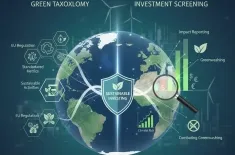Master carbon accounting and leverage transition finance to achieve net-zero commitments. Learn about tools, Scope 3 emissions, and financing decarbonization.
The global imperative to combat climate change has placed a monumental task on businesses and financial institutions: achieving net-zero commitments. This goal requires a radical, systemic shift away from carbon-intensive operations and toward a sustainable, low-carbon economy. At the heart of this transformation are two critical and interdependent pillars: rigorous Carbon accounting and strategic transition finance.
While carbon accounting provides the essential metrics to measure emissions and track progress, transition finance offers the crucial capital needed for financing decarbonization—particularly for the "hard-to-abate" sectors like cement, steel, and heavy transport. This article delves into the symbiotic relationship between these two fields, exploring the challenges, the specialized tools and investment products, and the immense opportunity they present for global climate mitigation.
Carbon Accounting: The Foundation of Climate Action
Carbon accounting is the methodical process of measuring, monitoring, and reporting the greenhouse gas (GHG) emissions generated by a company, organization, or product. It acts as the financial ledger for climate impact, moving the concept of emissions from an abstract environmental concern to a quantifiable business metric that can be managed, audited, and optimized.
The universally accepted framework for corporate carbon accounting is the GHG Protocol, which categorizes emissions into three scopes:
- Scope 1 Emissions: Direct emissions from sources owned or controlled by the company (e.g., burning fuel in company-owned vehicles or industrial processes).
- Scope 2 Emissions: Indirect emissions from the generation of purchased energy (electricity, heat, or steam).
- Scope 3 Emissions: All other indirect emissions that occur in a company’s value chain, both upstream and downstream.
The Scope 3 Challenge and Strategic Imperative
While Scope 1 and 2 emissions are typically easier to track, Scope 3 emissions often represent the vast majority—up to 80-90%—of a company's total carbon footprint, especially in sectors like finance, retail, and manufacturing. These emissions are generated by suppliers, customers, and other indirect activities like business travel and waste disposal.
Accurate accounting of Scope 3 is not just a compliance exercise; it is a strategic imperative. The difficulty lies in obtaining reliable data from hundreds or thousands of suppliers and customers, making aggregation and standardization a significant challenge. However, a robust understanding of Scope 3 is non-negotiable for companies serious about their net-zero commitments because it reveals the true levers for deep decarbonization across the entire value chain.
The Role of Carbon Data in Finance
For the financial sector, carbon accounting is the key to managing climate-related risks and opportunities. Financial institutions (FIs) use carbon data to:
- Assess Financed Emissions: Measure the GHG emissions associated with their lending and investment portfolios (a form of Scope 3 for FIs).
- Evaluate Transition Risk: Identify companies in their portfolios that are highly exposed to carbon pricing, regulatory changes, or technological obsolescence due to their high carbon intensity.
- Set Science-Based Targets: Establish credible net-zero commitments for their own operations and their financing activities, often aligned with frameworks like the Science Based Targets initiative (SBTi).
Without standardized and verifiable carbon data, the financial system cannot effectively price climate risk or allocate capital efficiently toward climate mitigation.
Transition Finance: Capitalizing the Shift
Transition finance is a specific category of sustainable finance dedicated to funding the efforts of high-emitting companies to drastically reduce their carbon footprint and shift their business models toward alignment with a 1.5°C global warming scenario.
It occupies a crucial space between "brown finance" (financing carbon-intensive activities without a climate strategy) and "green finance" (financing already clean or purely renewable projects). Transition finance acknowledges that the world cannot simply shutter all high-emitting industries overnight; it must instead fund their transformation.
Defining Transition
The core challenge of transition finance is establishing a credible definition that avoids "greenwashing"—where funds are simply used to prolong the life of polluting assets. Credible transition activities generally fall into two categories:
- Transitional Activities: Investments in existing high-carbon assets or processes to significantly improve their environmental performance (e.g., upgrading a steel mill with breakthrough low-carbon technology).
- Enabling Activities: Investments in infrastructure or innovation that are essential for the broader transition but may not be low-carbon themselves yet (e.g., building high-voltage transmission lines to support future renewable energy integration or financing the R&D for next-generation carbon capture technology).
Crucially, any project financed by transition finance must be part of a company's credible, public transition plan that includes specific, measurable, time-bound, and verifiable milestones for reducing Scope 3 emissions and achieving long-term net-zero commitments.
Tools and Investment Products for Financing Decarbonization
To successfully execute financing decarbonization, the financial market has developed a suite of specialized tools and investment products designed specifically to finance a company's transition from high-carbon to low-carbon operations.
Sustainability-Linked Bonds (SLBs) and Loans (SLLs)
Mechanism: Unlike traditional "Use of Proceeds" bonds (like Green Bonds) where the funds must be used for a specific green project, SLBs and SLLs tie the financing terms to the borrower's overall sustainability performance.
Decarbonization Focus: The interest rate or coupon of the financing instrument is explicitly linked to the achievement of ambitious, predefined Sustainability Performance Targets (SPTs). If the company achieves its Scope 3 emissions reduction targets, the cost of capital decreases; if it fails, the cost increases. This provides a direct, financial incentive for senior management to meet their net-zero commitments.
Transition Relevance: This product is ideal for high-emitting companies because it can finance general corporate purposes, allowing them to redirect capital to complex, company-wide transition initiatives without being restricted to a single green project.
Transition Bonds
Mechanism: These are fixed-income instruments where the proceeds are earmarked for projects that facilitate a company's pathway toward a low-carbon economy. They are essentially 'Use of Proceeds' instruments but with a transitional focus, targeting activities that may not yet meet the strict "dark green" criteria of traditional Green Bonds.
Decarbonization Focus: They finance large-scale, capital-intensive shifts, such as the gradual phase-out of coal-fired power plants while simultaneously financing decarbonization of new renewable energy capacity, or investment in hydrogen-ready infrastructure.
Credibility: Issuance is guided by external frameworks (like the ICMA's Climate Transition Finance Handbook) which mandate transparency, disclosure of the issuer's overall climate strategy, and alignment with the Paris Agreement's goals.
Blended Finance Mechanisms
Mechanism: This involves strategically combining concessional (public or philanthropic) finance with commercial (private) finance to de-risk projects and make them attractive to mainstream investors.
Decarbonization Focus: Blended finance is vital for highly innovative or frontier technologies critical for climate mitigation (e.g., advanced battery storage, green hydrogen production) or for transition projects in emerging markets where perceived risk is higher. The public capital absorbs the first layer of risk, enabling the private sector to participate.
Carbon-Related Derivatives and Hedging Tools
Mechanism: Financial instruments that allow companies to hedge against the future price of carbon emissions or carbon credits.
Decarbonization Focus: As carbon pricing mechanisms (like Emissions Trading Schemes) become more widespread, these tools allow high-carbon firms to manage the financial volatility of their carbon liabilities. This stability in future cost projections can unlock the investment confidence needed for long-term financing decarbonization projects, as the return on investment for efficiency or low-carbon technology becomes more predictable against a rising cost of carbon.
The Symbiotic Relationship
The relationship between Carbon accounting and transition finance is reciprocal and essential for accelerating climate mitigation:
- Accounting Enables Finance: Robust, auditable carbon accounting, especially of Scope 3 emissions, provides the transparency and data integrity that financiers require. This data is the basis for structuring and pricing all transition finance products—from setting the SPTs in an SLL to evaluating the credibility of a Transition Bond. If the emissions data is poor, the financing will be expensive or unavailable.
- Finance Drives Accounting: The demand for transition finance incentivizes high-emitting companies to invest in better carbon accounting systems and expertise. To access capital at a lower cost, they must demonstrate credible, measurable progress on their net-zero commitments. This financial incentive acts as a powerful governance mechanism, accelerating the adoption of best-practice carbon measurement and disclosure.
Ultimately, the goal is to shift capital allocation from activities that increase climate risk to those that contribute to a collective, sustainable future. This shift is impossible without a standardized, verifiable language for emissions (carbon accounting) and a dedicated mechanism for channeling funds toward change (transition finance).




























